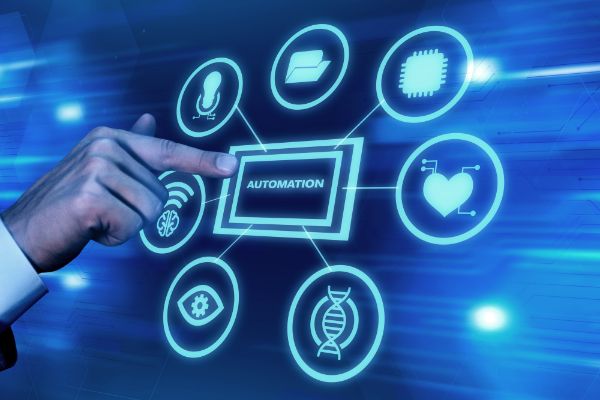Automation has taken over nearly every field in business, and HR is no exception. The fact is, running an HR department denotes the number of important tasks that can be unfortunately underdeveloped in favor of the more monotonous, laborious ones. With automation changing and growing more and more advanced by the day, there are a number of ways to utilize this technology to make the entire department’s day-to-day more simplistic.
This automation often finds itself in the form of a SaaS or “software-as-a-service” application. Companies nowadays rely heavily on SaaS apps to streamline their processes. According to statistics, the average company uses around 254 SaaS apps. That’s why it’s important to consider investing in these apps to help your business grow and succeed.
If you’re unfamiliar with automation’s role in HR, its benefits, and the different types of tasks and services that automation can provide, use this article as a brief guide to determining how you could potentially begin implementing automation into your own HR practices.
Image by Freepik
Simplified Recruitment and Onboarding
Welcoming new employees is always a pleasure, but the number of administrative tasks that go along with this process is less than pleasant. Fortunately, automation has made these tasks less straining on staff members. One component that is particularly appealing is the development of applicant training systems (ATS).
ATS can automatically post job openings to any number of job boards, social media platforms, or career websites with ease. This can save you loads of time and effort, avoiding having to punch in the information manually. It can also automatically screen and filter resumes based on things like qualifications, experience, or even specific keywords. That way, you can easily identify qualified candidates and give them your fullest attention instead of taking time to weed out the obviously unqualified.
Onboarding documents, like offer letters and contracts, can be distributed automatically to your new hires so that the necessary paperwork is completed before they begin. Errors and delays can be reduced, which is a significant relief. The collection of new hire information can be streamlined too, meaning that personal details and tax information can be filed easily through self-service portals.
To implement an ATS into your company, simply research and identify potential competitors for their benefits. Each is unique, as some ATSs, like Greenhouse, offer personalized interview kits for you before candidate interviews, and some, like Lever, allow candidates to self-schedule.
You want to ensure that promising employees who might have not fit the position they applied for will try again in the future. This is another reason HR automation is important. According to G2, 80% of job seekers said they would be dissuaded from considering other job openings at a company that did not give them any status on their application. However, they would be 3.5 times more likely to re-apply if they were given status updates in previous application cycles.
Easier Data Management
When it comes to data management, HR automation tools, like human resource information systems (HRIS), can automatically collect, store, and manage your employee’s data with minimal hassle. Human errors can then be eliminated, and your staff can dedicate their time to more complex tasks.
Self-service portals are also a lifesaver, with employees updating their own personal information. If they’re directly imputing and managing their data, the burden on the HR team is thus greatly reduced. The same goes for things like enrolling in benefits programs or requesting time off. This data can be automatically routed and updated with a measurable decrease in the need for any kind of manual intervention.
Some believe that implementing an HRIS is more suitable for large companies, but this is based on your personal discretion. An HRIS can be effectively used by any company, as people analytics can help any organization make data-driven decisions that assist higher employee engagement and retention.
The data collected in your HRIS can also be cross-checked for verification through automation tools. Your team won’t have to spend time gathering and addressing errors in data because the system can detect these for them. Metrics, like diversity statistics and turnover rates, can be easily seen and accessed as they become filed into one cohesive space.
Optimized Employee Performance Management
Perhaps one of the most important tasks of any HR department is performance management. In order to know if your company is running smoothly, you need to know that your employees are performing efficiently. However, despite being one of the most important tasks, it can also be one of the most boring. Fortunately, there are many ways that automation can simplify the process.
A growingly common form of HR automation for employee management is HR bots. Automated solutions for handling a variety of requests and approvals, such as PTO, are frequently utilized by organizations to optimize the management of employee experiences. These HR bots are the most prevalent form of automation, constituting 39% of all employee experience automations.
HR automation tools can also automate the process of setting and tracking employee performance goals. This can include setting SMART (Specific, Measurable, Achievable, Relevant, Time-bound) goals, aligning them with objectives, and then tracking their progress throughout the performance period. The tools can also send reminders or notifications to both employees and managers to ensure that timely progress is being made toward goal attainment.
Of course, automation is excellent for metrics. The tools can generate real-time analytics that can provide your team with completely up-to-date insights in the form of performance trends and areas of improvement. It can even help you to identify and subsequently recognize employees that are performing notably well during a certain period.
Even performance reviews can be assisted with this technology, automating the scheduling, feedback collection, and evaluations. Whether in the form of online self-assessment forms or collation and analysis of feedback, the process can become much more efficient and consistent than in the past.
The Implementation Process
Once you’ve decided you’re ready to add automation to your HR department, consider what this implementation process may look like to make it as seamless as possible.
Sometimes, employees can raise concerns about automation or resist the change. It is very important to address their concerns and communicate your reasoning for the change as clearly as possible. Educate them through training, and be sure to clarify expectations both on your end and the end of the employees. This can mitigate resistance and make the process much less bothersome for all parties involved.
An additional factor to be mindful of is that HR professionals need to ensure that the automation tools comply with relevant data protection regulations such as GDPR, CCPA, and other laws. This includes ensuring that employee data is collected, stored, and processed in a secure and compliant manner. HR professionals should work closely with their IT and legal teams to ensure that the automation tools meet all the necessary data protection requirements.
If you carefully consider these elements and weigh in the many benefits these automation tools will bring to yourself and your company as a whole, you’ll find that transitioning into automation will bring a new-found level of prosperity that your department has yet to see.






Leave A Comment